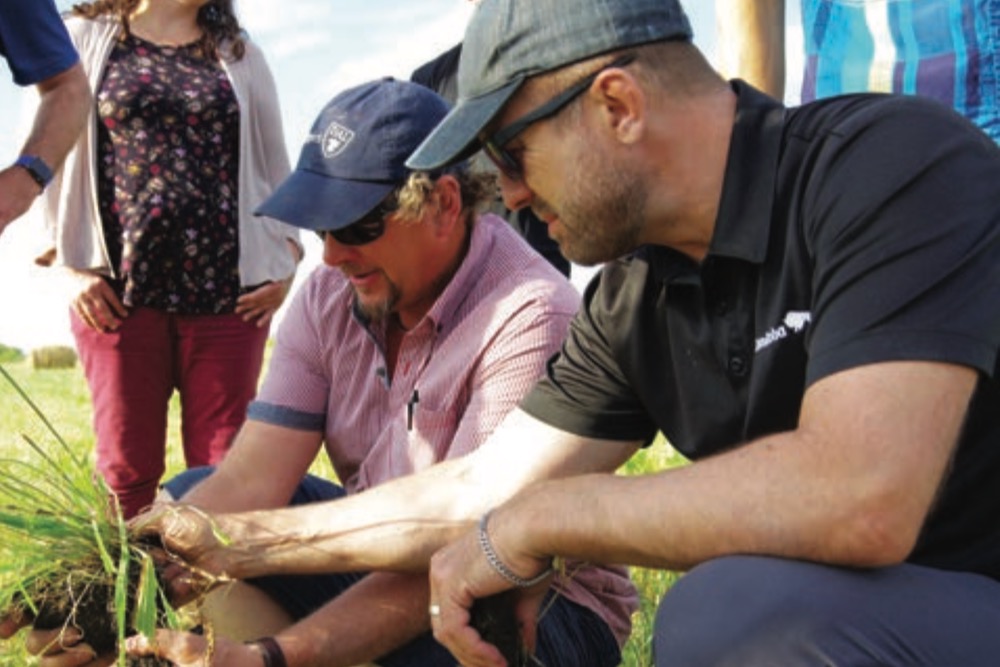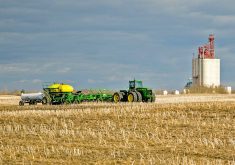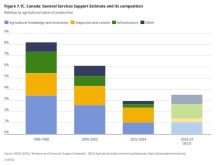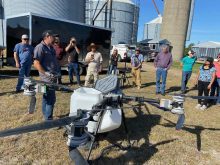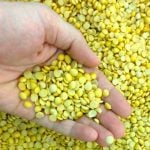Regenerative agriculturalists have a visually evocative word for ground cover: soil armour.
It means crop residue or living plants that hold the soil together and protect it from erosion.
The soil could’ve used some armour this spring, according to one first-hand account.
“I’ve never seen so much displaced soil,” said Elie-area farmer Justin Girard, referencing a video he had taken of flood waters carrying waves of soil, and another of dirt blowing in a high spring wind.
“Something has to be done,” he said. “We’re not just losing nutrients, contributing to nitrous oxide pollution in the atmosphere, but full-on shedding soil.”
Why it matters: A shorter growing season, cost and work flow have been some of the reasons for historical reluctance around cover crops, particularly in large grain farmers who cannot recoup cost though grazing.
He’s not the only one concerned. The topic comes back every time something extreme happens, according to Marla Riekman, provincial soils specialist.
And each time the topic comes up, cover crops are liable to be mentioned. They hold things together, the regenerative agriculturalists say. They suck up excess water and, for good measure, are a means of sequestering carbon, playing into that heated debate in the ag sector.
For all that praise, however, and despite growing interest and support through aid and management practice programs, it’s not like every farmer is jumping on board.
A 2020 survey from the University of Manitoba asked farmers what they thought would help them grow more cover crops. In the top five responses, four involved financial incentives. The other was more research specific to the Prairies.
In Manitoba, both solutions are in the works.
Watershed districts share costs, information
In the Seine Rat Roseau Watershed District (SRRWD), a new cover crop cost-sharing program got more than three times the applications it could fund.
The program offered an equally split cost share, up to $5,000, for farmers to buy cover crop seed and plant it. The idea was to alleviate the risk of trying cover crops for the first time, said program co-ordinator Dorthea Gregoire.
The district defined “cover crop” loosely, Gregoire said. Producers can plant “shoulder-season” crops — planting after cash crop harvest and terminating in spring — full-season cover crops or even in-season intercrops.
A quick search shows SRRWD isn’t the only district offering cover crop help.
The Central Assiniboine Watershed District has an application for a similar program on its website. It offers $30 per acre in compensation, as does the Assiniboine West Watershed District.
The Pembina Valley Watershed District also offered a similar program this spring.
SRRWD’s efforts also include providing resources and support for its farming members.
“A lot of times producers who, even if they are interested in (cover crops), were just overwhelmed and not sure what was applicable… Will it work for me here in Manitoba?” Gregoire said.
SRRWD worked with University of Manitoba researcher Yvonne Lawley to develop “Cover Crops 101,” an information and planning tool that helps a producer figure out their cover crop goals, plan what window to plant in, what species to plant and how to strategize seeding and termination.
Gregoire added that Covers and Co., a cover crop and forage seed supplier, has offered education and support for farmers in its area. The company sells pre-mixed cover crop blends that are good for getting started, Gregoire said. Many of their program members are using these blends.
Demographics
Across the Prairies, it’s mainly mixed or livestock farms that grow cover crops, according to a survey by Lawley and Callum Morrison, also of the University of Manitoba.
That’s typically been the pattern in SRRWD, Gregoire agreed. Growers have been concentrated in the southern end of the watershed, which is dominated by smaller, mixed farms. They seem to have an easier economic transition, because they can graze the cover crop, she said.
Offering a cost share, however, seems to have made it more worthwhile for other types of farms.
“It’s allowing us to expand our reach to some of the bigger crop growers farther north, and across our district,” Gregoire said. “We had applications from all sectors.”
More research
Farmers and researchers are also working together to figure out how cover crops work in rotations across the province.
Lawley is in the third year of a study with five farmers, covering six fields, who are growing replicated strips of cover crop each year in a field, but otherwise growing their rotation as usual.
They’re not testing individual species but are choosing cover crops based on their rotation and conditions. Part of the project is to find out where cover crops do and don’t fit in, Lawley said.
The study will also cover what purported cover crop benefits accumulate, and to see how the cover crops fit into the cropping and farm system, such as how they work with equipment, or rotation.
This year, four of six fields were planted to rye cover crops, which will provide information on how fields will come out when growing rye after a drought, followed by a very wet spring, Lawley said.
Fellow researcher Virginia Janzen and Lawley recently finished a study in which they looked at fall rye termination timing, in which the cover crop preceded soybeans.
Fall rye is a popular option for fall seeding in northern regions.
“Weather can always throw a wrench into our well-intentioned plans,” the pair wrote in the late-2021 edition of Pulse Beat. “What could happen if your plan to terminate 14 days before planting is forced to (be) changed?”
They tested termination at 14 days prior to planting, four days before planting, and one day after planting. There was no yield difference.
“Although the experiments occurred during dry years where soybean yields were limited, it was interesting to learn that there could be more flexibility in spring termination for fall rye when soybeans follow,” the researchers wrote.
“One day, when wetter conditions return to Manitoba, this experiment has also demonstrated the potential to manage fall rye cover crop biomass in order to dry soils ahead of soybean planting,” they added.
Well, wetter conditions have returned.
“I could see that this year, with this rain and the delayed planting and the funding, we might have some farmers who are wanting to grow a full-season cover crop to bring their wet fields back into production,” Lawley told the Co-operator.
Wider strategy needed
Despite that promise, cover cropping and other practices touted for building resiliency, like zero till (still a conundrum in the flood-prone Red River Valley), can only do so much against major events like this year’s flood, Riekman said.
Likewise, said Girard, better water management is also needed.
He pointed to his property along the La Salle River. The small river has two drainage channels “hammering this tiny river” with more water than it can take and providing an inevitable environment for topsoil erosion, he said.
There must be ways to, at very least, slow the water down as it drains toward the river, he said.
“We need to be more creative, I think, collectively in finding ways for farms to better protect their true wealth, their real resources, which is their soil,” he said. “We can’t afford, in the state of the world that we’re in, to be letting that wash away.”


